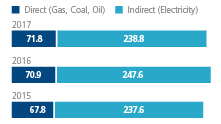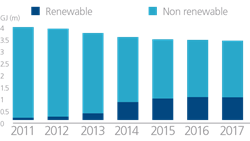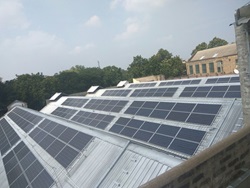Energy saving initiatives
We recognize that the Earth’s climate is changing, and as an energy user we have a role to play in reducing our contribution to it. The burning of fossil fuels for power and heat is the single largest source of greenhouse gas (GHG) emissions globally.
At Coats, we constantly review our manufacturing processes to improve efficiency, not only to minimize the cost to our business, but also to minimize the impact we have on the world around us. As such, we have focused on reducing our energy consumption and have seen a significant reduction in our carbon footprint since 2011.
The reduction to date was achieved through a combination of investment in energy efficiency – such as using better manufacturing schedules, regular maintenance and optimizing building management – as well as investment in new technology.
Reducing our energy usage
In 2017 we used 823 million kWh of energy (electricity and fossil fuels) in manufacturing our products, which is an overall reduction of 1% in total energy use from 2016 (829 million kWh), 1.2 % from 2015 (833 million kWh), and 4% from 2014 (858 million kWh). During this same period, we increased production by 9%, so our use of energy per unit of output has dropped by 13%.
The total carbon footprint of our manufacturing operations in 2017 (Scope 1 and Scope 2*, **) was 311 thousand tons, down 2% compared to the previous year (319 thousand tons). In terms of the products we manufacture, we have decreased our GHG emissions per unit of dyed product to 4.3 kg CO2e per kg (compared to 4.6 in 2016).
Although we have consistently used less energy year on year, our CO2 footprint in 2016 was slightly higher than the preceding and subsequent years' because of a shifting balance of production between countries and an increase in in-house electricity generation in Bangladesh due to shortages in grid supply.
Global GHG emissions (k tons CO2e)*,**

*Based on IEA CO2 Emissions from Fuel Combustion, OECD/IEA, Paris, 2017 and the 2017 UK DEFRA GHG reporting guidance and conversion factors. Includes Scope 1 – direct emissions from the combustion of fuel (gas, coal and oil) and Scope 2 – indirect emissions from the purchase of electricity.
**Emissions reported are from energy consumption in our global operations and exclude emissions from refrigerant usage and business air travel, which each have historically represented less than 2% of GHG emissions resulting from our manufacturing operations.
Investing in renewable energy
Over the past 5 years, we have actively sought to increase the amount of energy that we generate or purchase from renewable sources and we are pleased to see that the proportion of energy sourced from renewables has now increased to 29%.


Our India team, for example, have setup solar generation agreements with energy suppliers, at both our Faridabad and Ambas sites. As part of these agreements, we provide the space for the energy suppliers to install the solar panels and we buy the electricity generated whilst they are responsible for carrying out operation and maintenance of the solar plants. At our Ambas site, we have now two solar generation agreements, the latest one was made in February 2017. The new solar plant will likely be completed in March/April 2018. Once completed this solar plant is expected to generate 13,800 to 15,000 kWh per day.
Energy saving initiatives
Wherever possible, we are investing in energy efficiency program and new technology to reduce our footprint, and encourage our units to undertake local initiatives that, if successful, can be adopted elsewhere.
The team in Romania, for example, made a number of modifications to the existing technology to reduce power consumption and implemented a trial of a new energy monitoring system. This new monitoring system allows them to track energy usage in detail across the plant over time as well as the related costs. It also tracks the changes in energy efficiency and generates key energy performance reports. This helped them understand where energy losses could be reduced as well as monitor energy consumption before and after implementing solutions.
As a result of this increased focus on efficiency they have:
- switched all their lighting systems to LED
- increased the energy efficiency of their steam driers by controlling the electrical frequency used during the drying cycle. This reduced the electrical energy consumption by 27% and
- launched a solar energy pilot
By the end of 2017, the team in Romania had successfully met their monthly average rate target of 5.01kWh/kg and reduced their yearly average rate from 5.15 in 2016 to 5.11 kWh/kg.
The success of the new monitoring system in Romania is such that we are reviewing extending the use of this system across the group.
